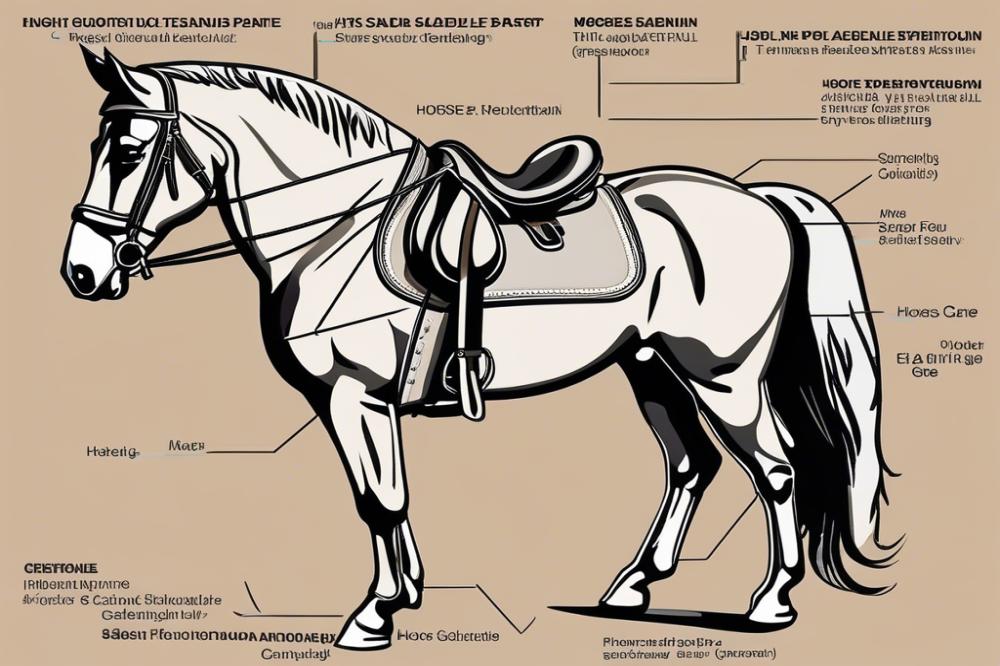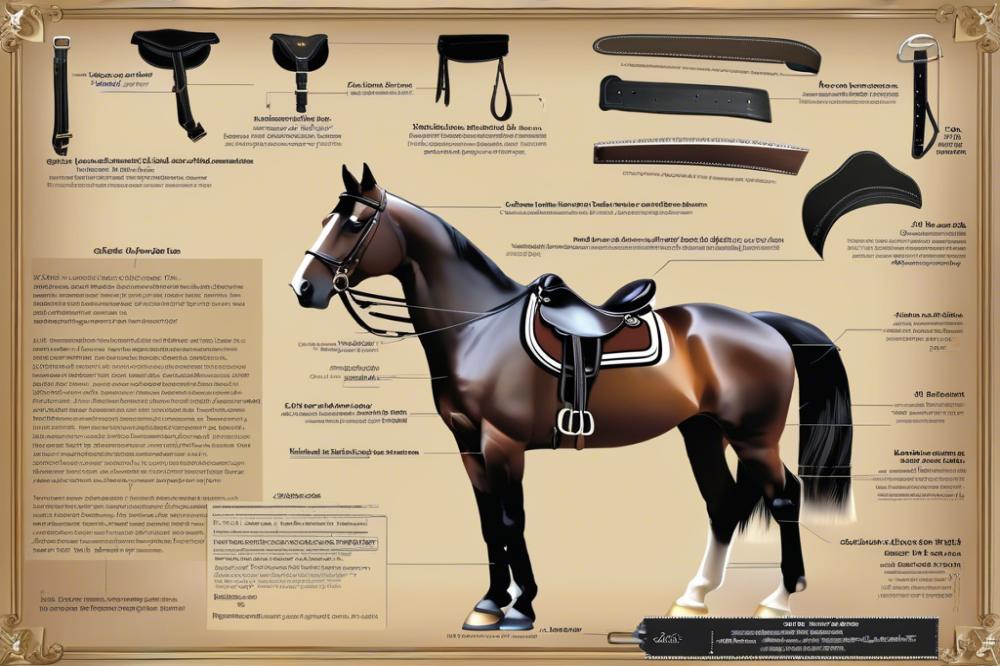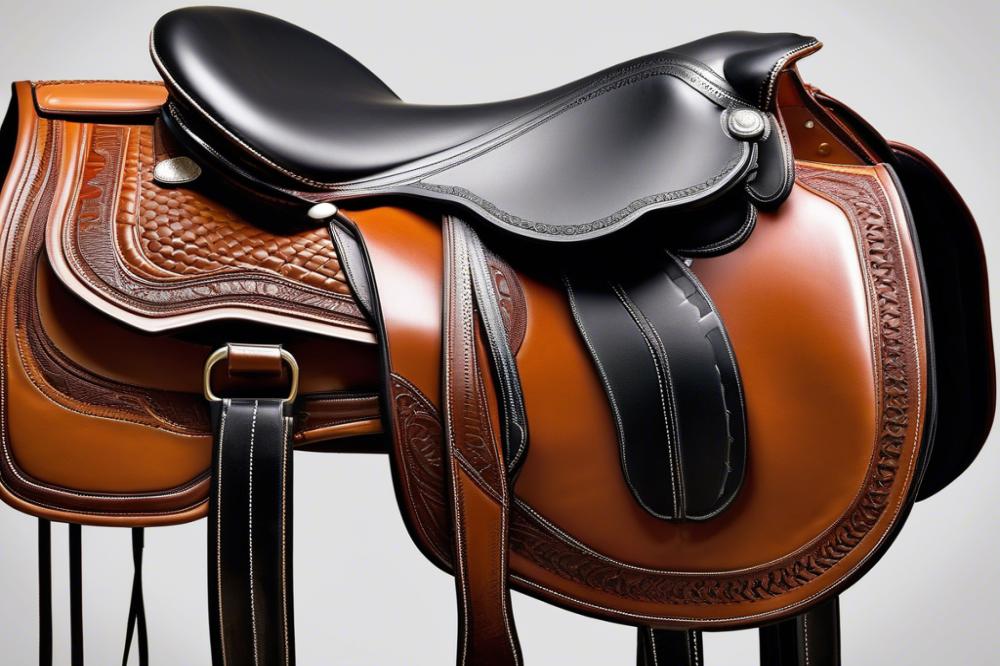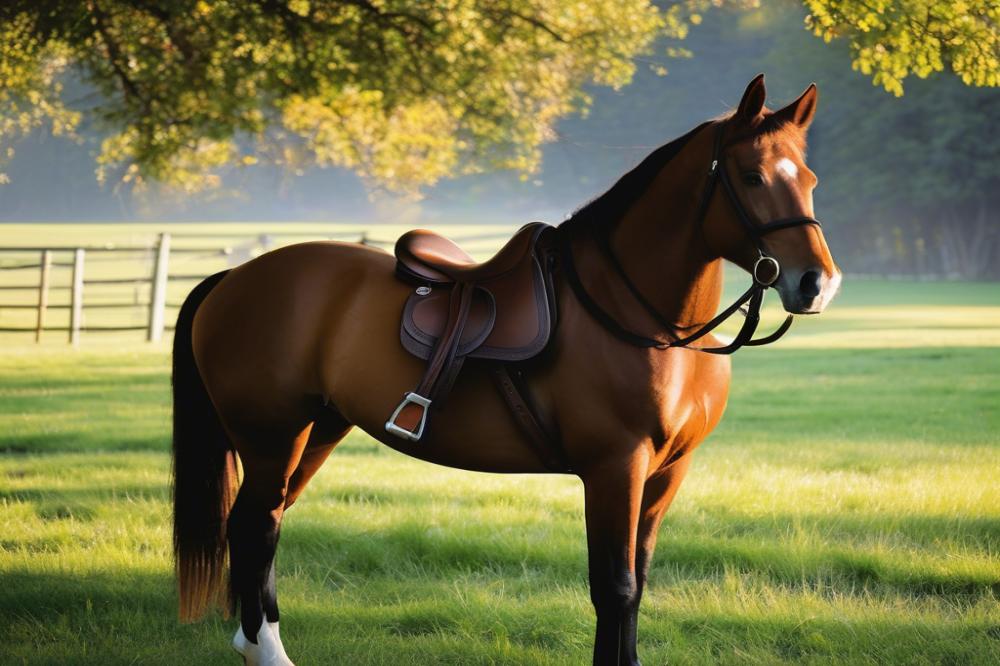Welcome to the World of Saddles
When it comes to horse riding, understanding the various parts of a saddle is crucial. These small but mighty saddle components play a big role in both the comfort of the rider and the well-being of the horse. Just imagine trying to ride a bike without knowing how to adjust the seat! In much the same way, knowing your horse riding gear means you can enjoy a smoother and safer ride.
Different Types of Saddles
Saddles come in all shapes and sizes, each designed for specific activities. For instance, a Western saddle has a unique shape and is ideal for cattle work and long rides. On the flip side, the English saddle is sleek and lightweight, tailored for jumping and dressage. Each design serves a purpose, making it essential to choose wisely based on what you plan to do. If you’ve ever wondered about the best fit for your adventures in the saddle, you’re not alone!
Why This Guide is Important
Looking to delve deeper into horse care or improve your equestrian techniques? This guide will be your trusty companion. It has been crafted to help you understand how each part contributes to a well-functioning saddle, what to look for when selecting one, and how they can support your riding journey. Think of it like a blanket guide horse for saddle enthusiasts! You’ll glean tips that could make your rides more enjoyable and perhaps even pave the way for better horse training.
Have you ever pondered the question, can horses eat pea straw? Well, this guide won’t cover everything about horse nutrition, but questions like that pop up in conversations among horse folks. Just remember, the more you know, the easier it gets when taking care of your cherished companion. Saddle knowledge may not be as exciting as a gallop through a field, but it’s certainly the backbone of a good riding experience.
So buckle up; we’re about to embark on a journey through the fascinating world of saddles and their parts!
Saddle Tree

Definition and Function of the Saddle Tree
The saddle tree serves as the core structure of a saddle. Think of it as the backbone of your horse riding gear. It holds the shape and gives support to both horse and rider. A well-designed tree helps distribute the rider’s weight evenly across the horse’s back. When the fit is correct, it can make a world of difference for everyone involved. It can help prevent discomfort and injury during those long rides. Without a solid tree, a saddle can be as useful as a chocolate teapot.
Materials Used for Saddle Trees
Different materials are used for making saddle trees, which can affect performance. Wooden trees, often made from hardwoods, are traditional and sturdy. They have a timeless look and feel, but can also be a bit heavy. Synthetic materials have become popular. They’re lightweight, and surprisingly durable, making them easy to handle. Some even have a layer of foam for added comfort. Whichever material you choose, it’s essential to find what works best for your horse and you.
Types of Saddle Trees and Their Implications for Fit
There are several types of saddle trees, and each has its own quirks. If you have a wide horse, a wide tree might be the way to go. It gives plenty of room for the horse’s shoulders to move freely. On the other hand, narrow trees can fit slimmer horses better but may lead to pinching. There’s also adjustable trees which can change shape. This adds flexibility, especially for growing horses. Each choice can dramatically impact your riding experience. Riding without the right fit can feel like trying to run in tight shoes—quite uncomfortable!
Every horse and rider combination is unique. What works wonders for one may not suit another. Hence, it’s critical to test different types of saddle components. Explore various options, gather information, and make a choice that fits your needs. Remember, comfort is key in equestrian techniques. Happy riding!
Seat

The seat is a vital part of the saddle. It’s where the rider spends a lot of time, so comfort is key. Built with various shapes and materials, each seat has its own personality. Some are soft and plush, offering that cozy feel, while others are firm and structured, providing more support. Choosing the right seat can feel like finding your favorite chair at home!
Design can vary quite a bit. Some seats are wide and accommodating, perfect for those long rides. Others are narrow and sleek, ideal for speed and agility. Size matters, too. A larger seat may be better for beginners or those who like extra room, while experienced riders might prefer a smaller seat for better connection with their horse. Think about it like choosing shoes; a good fit makes all the difference.
Seat shape also affects balance. A flatter seat helps distribute weight evenly, which is great for stability. Conversely, a deeper seat can help keep a rider in place, especially during sudden movements. The right shape can lead to a more enjoyable ride, helping both horse and rider feel at ease. Riders using proper equestrian techniques will notice this difference, especially when dealing with unexpected twists and turns.
When it comes to horse riding gear, don’t underestimate the importance of the seat. It’s not just about looking good; it’s about feeling good, too! After all, nobody wants to end a ride with sore legs or an aching back. Taking time to choose the right seat can make each ride more rewarding. Think of it as investing in your experience, similar to horse care but for the rider.
Panels

Let’s dive into saddle panels. These parts play a crucial role in how your horse feels while riding. Think of them as the cushy part of a chair. Just like you wouldn’t want to sit on a hard surface for too long, your horse needs a comfortable spot too. The panels help distribute the rider’s weight evenly across the horse’s back. This not only boosts comfort but also helps prevent soreness.
Different Panel Types and Configurations
There are several types and configurations to consider. Some saddles have wool-flocked panels, while others use foam or synthetic materials. Wool panels can mold to the horse’s shape over time. This adaptability provides a custom fit that can enhance comfort. Foam panels, on the other hand, offer a firmer feel. They might not adjust as much but can be lightweight and easy to maintain.
Panel shape and design can also vary quite a bit. Some are flatter, ideal for horses with a broad back, while others might be more curved to suit a narrower shape. Consider this when you choose your horse riding gear. A good fit means less chance of pinching or rubbing, which is a win-win for you and your equine partner.
Importance of Panel Fit for Horse Comfort and Performance
Now, let’s not underestimate the importance of panel fit. If the panels don’t match your horse’s shape, you could end up with more than just discomfort. A badly fitting saddle can lead to behavioral issues during horse training. Ever heard the saying, “No pain, no gain”? Well, that doesn’t apply here! If your horse is uncomfortable, it won’t perform well.
An excellent panel fit allows for free movement. This freedom is essential for the horse when galloping, turning, or jumping. The right configuration sets the stage for successful equestrian techniques. Plus, it helps you maintain better control. Everyone wins when panel fit is prioritized—your horse enjoys the ride, and you look great during your lesson.
In the world of equestrian equipment, paying attention to panels is key. When shopping for saddles, don’t skimp on finding the right fit. Getting it right from the start can save you from frustration in the long run. Remember, happy horses make happy riders!
Flaps
Role of Flaps in Saddle Functionality
Flaps are often underestimated, but they are vital parts of any saddle. Their main job is to connect the rider to the horse. Think of them as a bridge between two partners. A good flap allows for better communication and supports the rider’s leg position. When flaps fit well, they help you feel your horse’s movements more clearly. That’s important when practicing equestrian techniques or during a ride. If the flaps are off, it can feel like trying to talk to someone through a bad phone connection.
Different Shapes and Sizes of Flaps
Flaps come in various shapes and sizes, much like people’s shoes. Some are shorter and rounder, while others are long and straight. Shorter flaps can be great for jumping. They allow for a more unrestricted leg position. On the other hand, longer flaps suit those who prefer a classic riding style, offering good support for more extended leg positioning. Each design offers unique experiences. So, if you’re shopping for horse riding gear, consider your riding style carefully.
How Flap Design Affects Leg Position and Communication with the Horse
Flap design plays a huge role in leg position. Riders with flaps that are too long might find their legs stuck out, making it hard to maintain balance. A snug fit, however, allows your leg to drape naturally. This position ensures better control and aids in sending signals to the horse. For example, squeezing your knees can signal a cue. The right flap can make you feel like you’re speaking a shared language. After all, effective communication is key in horse training. So, when picking your saddle components, remember that flaps aren’t just there for show; they’re essential for making any ride feel smoother and more connected.
Girth and Billets
Description of the Girth and Its Function
The girth is a crucial part of the horse riding gear. Think of it as the belt for your horse’s saddle. Its main job is to keep the saddle securely in place while you ride. If the girth is too loose, the saddle might slide around, making things uncomfortable for both you and your horse. A snug fit is vital for safety and comfort. This way, you can focus on riding instead of wrestling with your equipment.
Types of Girths and Their Applications
Girths come in several types, each with its own purpose. For instance, the regular web girth is popular for everyday riding. It’s durable and straightforward, making it suitable for all kinds of equestrian activities. On the other hand, a fleece-lined girth is softer against the horse’s skin. It’s great for horses with sensitive skin or those prone to chafing.
There are also anatomical girths, designed to fit the horse’s shape better. They help prevent slip and allow for more freedom of movement. If you are into jumping, a jumping girth is usually elasticized. This feature offers flexibility while keeping everything secure during those exciting leaps.
Explanation of Billets and Their Significance in Saddle Attachment
Billets are more than just fancy bits of leather. They play an essential role in connecting the girth to the saddle. Typically, they are situated on either side of the saddle, providing the necessary anchor points. Without them, the girth would have nowhere to attach, and you can imagine how chaotic that would be while riding!
When using different girths, it’s important to check the billets. Some saddles have short billets for a more traditional look, while others feature long billets, allowing for more options in girth placement. This can affect the overall fit and comfort, ensuring that both horse and rider have a pleasant experience.
In summary, understanding girths and billets can greatly enhance your horse care and riding practices. The right choice can make training sessions smoother, letting you focus on mastering equestrian techniques instead of battling with equipment. So, next time you gear up for a ride, give a little thought to those unsung heroes, the girth and billets.
Stirrups and Stirrup Straps
Overview of Stirrups and Their Types
Stirrups are those handy little loops you put your feet in while riding. They may seem simple, but they come in various types, each designed for different styles and purposes. A classic stirrup is often made of metal or rubber. There are even lightweight materials like aluminum for competitive equestrian events. Western riders often use a wider, flatter stirrup, while English riders prefer a narrower design. Some stirrups feature safety mechanisms that release easily if you fall. Wouldn’t you rather tumble without getting stuck?
Importance of Stirrup Strap Length and Design
Getting the right length of the stirrup strap is crucial for comfort. A strap that’s too short might force you into an awkward position, while one that’s too long can feel like you’re riding a pogo stick! Adjusting the stirrup length ensures that your legs are in a natural position, making it easier to control your horse. Design plays a role too. Just like you wouldn’t wear shoes that don’t fit, your stirrup straps should be well-made to support your riding style. Believe it or not, even the color can matter! Some riders think a bright strap adds flair, while others prefer classic black.
How Stirrups Affect Rider Safety and Stability
Stirrups are not just there for decoration. They play an immense role in keeping you stable. When you’re riding, your feet should feel secure in those stirrups. If they slip out, you might end up in the dirt (and not in the cool way!). Properly fitted stirrups also help maintain your balance. This balance is crucial when learning various equestrian techniques, especially during sharp turns or sudden stops. Think of them as a life jacket, keeping you afloat when things get rocky.
In the world of horse care, safety first means having reliable horse riding gear. It’s always smart to check your gear! Riding isn’t just about sitting on a majestic creature; it’s about working together as a team. The right stirrups and straps can make all the difference between a smooth ride and an unexpected dismount. So next time you gear up, don’t overlook these important components. Your feet—and your horse—will thank you!
Fenders and Leathers
Function of Fenders in Western Saddles
Fenders are essential components of western saddles. They serve as support for the stirrups and help distribute your weight evenly. Imagine riding a horse without them; it would be like trying to balance on a seesaw with no center! Fenders also protect your legs from rubbing against the saddle, making your ride more comfortable. With proper equestrian techniques, fenders can enhance your connection to the saddle and the horse. They allow for better communication with your steed. After all, a good ride is all about harmony.
Different Types of Leathers Used in Saddle Construction
Various kinds of leather are used in making saddles. Cowhide is among the most common; it is tough and durable. Many saddles are made from this type. There’s also the softer, more luxurious kangaroo leather, often chosen for its lightweight properties. Some riders prefer this for long-distance travel. Exotic leathers like ostrich or alligator give saddle components a unique flair but come with a hefty price tag. Choosing the right type of leather is essential for comfort and durability. Each type of leather brings its own flavor to horse riding gear.
Maintenance and Care for Fenders and Leathers
Keeping fenders and leathers in great shape is easier than it sounds. Regular cleaning can save you from bigger headaches down the line. Use a soft cloth to wipe off dirt after each ride. Applying conditioner helps keep the leather supple and prevents it from cracking. Think of it like moisturizing your own skin after a long day in the sun! Storing saddles in a cool, dry place also helps maintain their longevity. A good rule of thumb is to check the fenders for wear regularly. Staying proactive means fewer surprises during horse training sessions. Remember, proper care is crucial for your equestrian equipment.
Bridle and Accessories
Relationship Between Saddle Parts and Bridle
When you think about riding, the bridle and saddle are two key players on the stage. They work together like a pair of dance partners. While your saddle supports you and keeps you secure, the bridle gives you control over your horse. Each piece of equestrian equipment has its distinct role in the dance of horse riding. If they don’t match well, it’s like trying to waltz in flip-flops. Just imagine the awkwardness!
Both saddle components and the bridle should complement each other. A poor fit or mismatch can affect handling, comfort, and overall performance. A good relationship between these pieces helps in developing effective equestrian techniques. Perfect harmony means better communication between you and your horse.
Common Accessories to Consider for Saddle Setup
Accessories can make or break your riding experience. Think about stirrups, girths, and girth covers. Stirrups come in various designs, all aimed to increase comfort and safety. The right girth is essential for keeping the saddle snug and avoiding any unwanted slippage during your ride.
A saddle pad is another accessory often overlooked. It can improve comfort for both you and your horse. Then there’s the bridle itself, which may include reins, browbands, and bit accessories. Choosing the right bit is important as it can significantly influence the way your horse responds.
Don’t forget about saddle bags! These are handy for carrying brushes, snacks, and other horse care essentials. It’s like having a stylish backpack when you go hiking—practical and fashionable!
Importance of Coordinating Saddle and Bridle for Overall Performance
Now, let’s chat about coordination. Just like a well-rehearsed play, everything needs to fit well together. Coordinating your saddle and bridle can elevate performance in a big way. Imagine trying to ride without realizing a piece of equipment doesn’t fit right—it can lead to confusion for your horse and frustration for you.
Using mismatched equipment can confuse not just the rider but the horse itself. The wrong bridle may cause discomfort, and that can lead to poor performance. When both pieces work together smoothly, you’re setting the stage for success in horse training.
To wrap it up, a little attention to detail goes a long way. With the right combination, you can enjoy a serene ride, feeling like you and your horse are in sync, like a perfectly tuned orchestra. Isn’t that the dream?
Wrapping It All Up
Understanding the various parts of a saddle really goes a long way in enhancing your riding experience. Each component plays its own role, just like a well-rehearsed orchestra. Get to know them, and you’ll be better equipped to make a choice that benefits both you and your horse. Imagine riding in a saddle that fits poorly—it’s kind of like that awkward moment when your shoe is two sizes too small. Not comfortable, right?
When it comes to selecting a saddle, focusing on its parts and ensuring a proper fit is crucial. You wouldn’t buy a pair of shoes without trying them on first, would you? Choosing a saddle should be no different! Take the time to learn about how the various parts like the tree, panels, and girth work together. A well-fitting saddle can make all the difference in how your horse performs. After all, nobody wants a situation where you’re questioning whether “does horse sit down” because you’ve put them in something that doesn’t suit them well.
Once you’ve found that perfect saddle, don’t forget about maintenance. Caring for your saddle is like nurturing a garden; regular attention can keep it flourishing. Wipe down the leather after each ride and don’t overlook the stitching. A stitch in time saves nine, as they say! And remember what you feed your horse too; even horse feed barley needs consideration while saddling. Proper nutrition contributes to overall fitness, which in turn can help your saddle’s performance.
So, whether you’re saddling up for a leisurely ride or an ambitious trail, remember that understanding those unique saddle components is not just a necessity, but an adventure in itself. Invest time in choosing the right fit, and keep up with the care—you’ll be galloping into a world of comfort and joy in no time!



